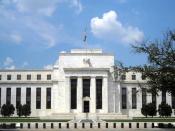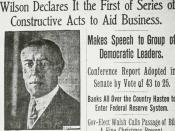IntroductionIn the wake of the subprime mortgage meltdown and the resulting financial disaster, policymakers are scrutinizing the financial regulatory structure. A key piece of this structure is the Federal Reserve Board (Fed) which is charged with managing the systemic risk to the financial system. Recent policy debates have center around whether or not the Fed should be stripped of its oversight of systemic risk, which would then be given to a new agency. This debate is simply a different side of a much older debate about the role of the Federal Reserve. For years policy makers have argued that the Fed has far too many mandates for one institution.
The Federal Reserve currently has several policy goals. The Fed is responsible for monitoring systemic risk in the financial sector and monitoring the stability of individual banks in order to protect the financial system. The Fed is charges with exercising monetary policy to insure "maximum employment, stable prices, and moderate long-term interest rates" (Simpson, 1).
The Federal Reserve is he central bank of the United States. Many central banks in foreign countries have only a single policy objective; maintaining the inflation rate of their currency at the level that they dictate. "The Bank of England and the European Central Bank" (Guha) both take this approach to monetary policy. The reason that a low inflation rate is seen as a good thing is that it creates price stability and helps preserve the preserve the value of government bonds. Government bonds are based on the monetary unit of the country that issued them so if inflation where to increase rapidly then the value of these bonds would decrease rapidly. Maintaining low inflation rates can conflict with other policy areas, such as those expressed in the Fed's mandate. This is why in practice...


